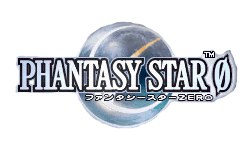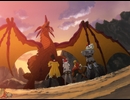|
|

|
PLATFORM
|
DS
|
BATTLE SYSTEM
|

|
INTERACTION
|

|
ORIGINALITY
|

|
STORY
|

|
MUSIC & SOUND
|

|
VISUALS
|

|
CHALLENGE
|
Moderate
|
COMPLETION TIME
|
20-40 Hours
|
|
OVERALL

|
+ Surprisingly engaging single-player mode.
+ Online mode works smoothly.
+ Plays mostly like a PSO on a handheld.
- Console version shortcuts are gone.
- Limited character creation options.
- Cannot save mid-dungeon progress.
|
Click here for scoring definitions
|
|
|
Just as the Phantasy Star Portable games are like PSP versions of Phantasy Star Universe, Phantasy Star Zero is like a DS version of the Phantasy Star Online games, sans PSO Episode III. The classes, action battle system, weapon and armor types, monsters designs, Techniques and so forth should be familiar to anyone who has played the Dreamcast original or its subsequent ports and sequels on the GameCube, Xbox and PC. While there are new positive traits, along with some sad shortcomings, to differentiate it from the console games, fans of PSO and similar hack-and-slash loot-collecting RPGs will likely enjoy PSZ.
PSZ's story mode is surprisingly straightforward, especially in comparison to the indirect storytelling of the PSO games. The game begins two hundred years after a terrible cataclysm known as the Great Blank, which nearly wiped out the human race, seemingly caused the Newmans (Phantasy Star’s elf-like race) to go extinct, and sent the CASTs (androids) into stasis. Humanity has managed to rebuild itself with the help of lost technology found in ruins. The CASTs have also begun to reawaken. All is not well, though, as an unknown group is trying to destroy these important ruins, and the monsters seems to be getting more hostile.
What really makes PSZ's plot interesting is that it plays out differently depending on the race of the player's character. While the basic plot and the ending is the same, each of the three versions start differently, vary the order of events, sometimes have distinct situations, and even some unique animated cutscenes. Players may wish to create one character for each of the three races in order to view these different takes on the story. While said story makes use of many JRPG and sci-fi conventions, it is not done in an overtly clichéd manner, and has enough twists to keep players' interest. The translation, while not quite Atlus or Nintendo caliber, is still decent, with the more humorous scenes making especially good use of the script.
The player character is never seen onscreen during story sequences, but is still fairly involved in the main plot. There are also three AI-controlled party characters and several NPCs with their own unique personalities. They are not the deepest of characters, but players do learn a little about the party members as the game progresses, and their banter can be pretty amusing. Over the course of the game, players can make dialogue choices, but these do not have any real effect on the story, and seem to serve little purpose than to see what sort of reaction the other characters make.
 No, I don't have any relatives on Ragol. I never even heard of Ragol before!
No, I don't have any relatives on Ragol. I never even heard of Ragol before!
|
|
As mentioned before, the combat is very similar to the hack-and-slash systems seen in games of the PSO series. Enemies are encountered and fought directly on the field. Normal attacks using the currently equipped weapon are by default set to the A button, though players can change this by going to the Palette option in the menu. By carefully timing the animation of the weapon, up to three attacks can be chained. Techniques, which are the Phantasy Star versions of magic spells, are different from previous PSO games. Rather than having a base Technique, like Foie, alongside its more powerful versions, Gifoie and Rafoie, the original ability no longer has separate stronger ones. Instead, by pressing and holding the button the Technique is assigned to, the icon in the Action Palette will change, and then upon releasing the button the upgraded version will be used (Foie to Rafoie). There is also a new dodge option, which causes the character to roll in order to avoid enemy attacks, and various traps. These and other options can be added to the Action Palette, being assigned to the A, B, or X buttons. An extra option can be assigned to these buttons and then activated by pressing and holding the R shoulder button. Several weapons also have abilities called Photon Arts, powerful moves that consumes some Photon Points, which Techniques also draw on. These can also be activated by pressing and holding the Normal attack button until the icon in the Palette changes.
While there are differences in the battle system from the original PSO, for the large part battles play out the same. Players engage an enemy or group of enemies, attacking or using Techniques, and either manually dodging to escape attacks, or hoping their evasion stat will allow them to avoid a physical move. Every so often a Photon Blast, similar to a summon, can be performed if the player's Mag, a small robotic ally that floats over the shoulder, is charged enough to deal a lot of damage. The same tactics work against bosses, though caution is necessary, as they can be difficult. The dodge option adds a bit more strategy, but otherwise, PSZ is straightforward hack-and-slash with only a few bells and whistles. Fans of the original PSO games should feel mostly at home. Those who do not like the PSO battle system, or grew tired of it, may not find this game’s combat of much interest. The smooth quickness of the combat helps to ease its repetitive nature, however. As may be expected, since the DS only has a D-pad, the lack of complete 360 degree movement may make combat a tad frustrating at times. It is never a serious problem, though. The AI-controlled characters in story mode, while not completely inept, tend to fight poorly and die a lot during boss fights.
There are three main classes in PSZ, as in PSO: close-combat Hunters, firearm-using Rangers, and magic-using Forces. These classes are divided into 14 sub-classes, depending on the combination of race and gender. The only combinations not possible are CAST Forces and Newman Rangers. Each sub-class has varying abilities, giving players a variety of choices to suit individual fighting styles. Sadly, while there are new sub-classes such as HUmarls (female human Hunters), the character creation options are extremely limited. There are only a few hairstyles, colors, and outfits, or access more than a few body types for CASTs.
Phantasy Star Zero relies almost entirely on button controls. The touch screen is only really used for the Chat and Short Cut options. Chat, also called Visual Chat, allows players to write a quick message, or even a drawing to communicate with other players over Wi-Fi. Short Cuts are saved phrases/images. While Visual Chat can be fun, one has to wonder why the game doesn’t make use of the microphone for voice chat, as it would make coordinating attacks easier. Also, Visual Chat can only be used when playing with someone who one has exchanged Friends Codes with. Playing with anyone else limits communication to set chats, which automatically translates into the other player’s native language.
There aren't many serious problems with the controls or the camera, but the shortcuts for weapons, armor, Techniques, and items are sorely missed. In past Phantasy Star Online games for consoles, aside from having several such options set to the action menu, players could also press certain buttons to access the entire list to use a different Technique, or to change an equipped weapon. Without these shortcuts in PSZ, players have to scrolls through the menu to change weapons or assign a different Technique to the Palette as there is no way to pause the game, even while sorting through the menu. This can and will leave characters open to danger during combat. It can especially be bad during boss fights. The game is able be saved anytime, and if saved and turned off while in the field or during a quest, it will have to be restarted. This isn't as troublesome as the console versions, since dungeons are shorter and the DS can be put into sleep mode.
 By your powers combined...
By your powers combined...
|
|
As far as 3D DS graphics go, Phantasy Star Zero's visuals are pretty impressive. There is still a fair amount of pixilated jaggedness, but this has come to be expected for DS games in 3D. Otherwise, the environments are quite detailed. Enemies and characters are also fairly well-designed. PSZ sports some very short animated cutscenes, which are quite good despite their brevity, as well as several still CG images during other important scenes.
The music in PSZ is very similar in style to other PSO games, which should come as no surprise as it has some of the same composers, such as Hideaki Kobayashi and Fumie Kumatani. Despite this similarity, there are arguably fewer noteworthy compositions here. The final dungeon and a few boss battles sport memorable music, but otherwise much of it is forgettable.
There is some voice acting during the few anime cutscenes, but it is so brief, it’s difficult to gauge its quality. Only one or two scenes are longer than a minute. It's not terrible enough to be noticeable, but the voiced scenes are so short, it probably won't leave much of an impression, for better or worse.
Phantasy Star Zero may as well be called Phantasy Star Online DS. This is not necessarily a bad thing, though opinions will differ depending on how much one likes PSO or games similar to it. Combat is fairly simple, but tearing a monster to ribbons with a pair of daggers or freezing it solid with Rabarta is still fun. It’s even more fun with another human player. Online multiplayer works very well, with no lag or other problems, even when playing with someone thousands of miles away. The story mode is not too shabby, either, with three plot variants holding the interest of even those players without access to the multiplayer components. Though it has its share of shortcomings, Phantasy Star Zero is a good way to enjoy a single-player or multiplayer action RPG on the go.
Review Archives
|









